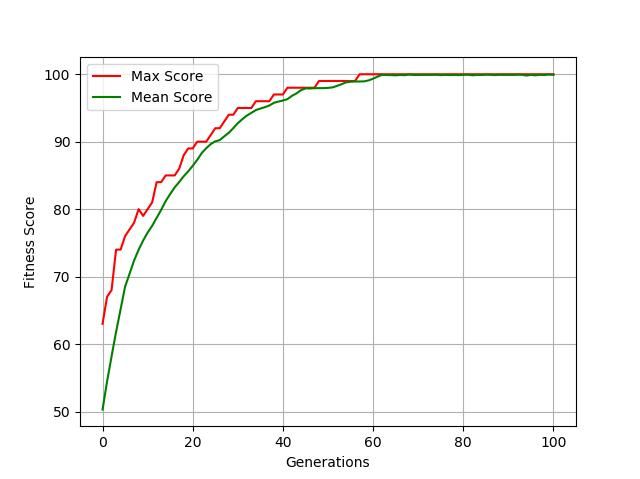遗传算法解决vrp问题_遗传算法(Python) #3 从零开始解决OneMax问题
上一期
1. OneMax问题(OneMax Problem)
OneMax问题是遗传算法的入门问题,其内容是:如何使一段长度固定的二进制字符串所有位置上数字之和最大。
让我们用一个长度为5的二进制字符串为例:
- 10010 -> 和为2
- 00111 -> 和为3
- 11111 -> 和为5(最大值)
对一般人,显而易见,当所有位数都为1时,该字符串的和最大,但在我们用遗传算法解决该问题时,遗传算法本身并没有这样的知识。接下来我们将不依靠任何遗传算法的包,从头开始用遗传算法解决OneMax问题。
2.问题的解决思路
首先,我们得把这个问题转换成一个遗传算法问题,即:我们得定义个体、种群,选择、杂交、突变方法、适应度函数等。假设有一个长度为100的字符串,我们可以做出以下定义:
- 个体:个体即为问题的解,这个问题中个体可以直观的定义为一个长度为100列表(List),列表上每个元素为0或1.
- 种群:种群即所有个体的合集,我们可以把种群定义为所有个体组成的列表。
- 选择:使用锦标赛法(Tournament Selection)
- 杂交:使用单点杂交法(Singe-Point Crossover)
- 突变:使用位翻转突变法(Flip Bit Mutation)
- 适应度函数: 我们的目标是使字符串上所有数字之和最大,适应度函数可以直观的定义为列表中所有数字之和。
若对上述定义不太了解的,可以回看遗传算法系列的第二期。
3.用Python实现遗传算法
以下将分步骤解释每一部分的代码,完整代码在本文的最后可见。
3.0.准备工作
import randomimport matplotlib.pyplot as pltrandom.seed(39)导入所有需要的包:
- random: 用于生成随机数
- matplotlib: 用于画图
- random.seed: 确定种子(即随机状态),这样每次运算我们都能得到同样的结果
3.1.定义个体和种群
# 1. define individual and populationdef CreateIndividual(): return([random.randint(0,1) for _ in range(100)])def CreatePopulation(size): return([CreateIndividual() for _ in range(size)])- CreateIndividual:个体即为一个长度为100的列表,每个元素(基因)为0或1。
- CreatePopulation: 种群即多个个体组成的列表。
3.2.定义选择、杂交、突变方法和适应度函数
3.2.1.选择
# 2.1. define select functiondef tournament(population,size): participants = random.sample(population,size) # evaluate function is defined in 3.4 winner = max(participants,key=lambda ind:evaluate(ind)) return(winner.copy())def select(population,size): return([tournament(population,size) for _ in range(len(population))])- tournament:从种群中随机抽取size个个体,从中选取适应度最高的个体。注意使用.copy以防同一个列表被多次引用。
- select:为了保持种群的大小不变,锦标赛的次数应与种群中个体的数量相同
3.2.2.杂交
# 2.2. define mate functiondef SinglePointCrossover(ind1,ind2): loc = random.randint(0,len(ind1)-1) genes1 = ind1[loc:] genes2 = ind2[loc:] ind1[loc:] = genes2 ind2[loc:] = genes1 return([ind1.copy(),ind2.copy()])def mate(population,probability): new_population = [] for i in range(0,len(population),2): ind1 = population[i].copy() ind2 = population[i+1].copy() if random.random() < probability: new_population.extend(SinglePointCrossover(ind1,ind2)) else: new_population.extend([ind1,ind2]) return(new_population)- SinglePointCrossover:单点杂交法的实现,两个个体交换随机位置及其后面的基因
- mate:对种群进行杂交,按一定概率每两个相邻的个体进行杂交probability参数:每次生成一个0至1之间的随机数,若随机数小于该概率,则进行杂交,否则对应的两个个体被克隆。
3.2.3.突变
# 2.3. define mutate functiondef flipOneGene(ind): loc = random.randint(0,len(ind)-1) ind[loc] = 1 - ind[loc] # 0->1 or 1->0 return(ind.copy())def mutate(population,probability): new_population = [] for ind in population: if random.random() < probability: new_population.append(flipOneGene(ind)) else: new_population.append(ind.copy()) return(new_population)- flipOneGene:位翻转突变,个体上的一个随机基因进行突变。
- mutate: 每个个体都以一定概率突变,若不突变,则该个体被克隆。
3.2.4.适应度函数
# 2.4. define evaluate functiondef evaluate(individual): return(sum(individual))OneMax的适应度函数就是列表中所有数字之和。
3.2.5.统计种群数据
# 2.5. define statistical metrics to monitor algorithm performancedef population_score_max(population): return(max([evaluate(ind) for ind in population]))def population_score_mean(population): return(sum([evaluate(ind) for ind in population])/len(population))为了追踪算法的进度和发现算法中可能出现的错误,我们可以统计每次迭代中种群适应度的最大值与均值。
3.3.运行遗传算法
# 3. Run genetic algorithmdef main( POPULATION_SIZE = 100, TOURNAMENT_SIZE = 3, CROSSOVER_PROB = 0.9, MUTATE_PROB = 0.1, MAX_GENERATIONS = 100): generation = 0 population = CreatePopulation(POPULATION_SIZE) max_scores = [population_score_max(population)] mean_scores = [population_score_mean(population)] best_individual = [] while generation < MAX_GENERATIONS: population = select(population,TOURNAMENT_SIZE) population = mate(population,CROSSOVER_PROB) population = mutate(population,MUTATE_PROB) # collect statistics max_scores.append(population_score_max(population)) mean_scores.append(population_score_mean(population)) best_individual = max( best_individual, max(population,key=lambda ind: evaluate(ind)) ).copy() generation += 1 print("Best Solution:") print(best_individual) plt.plot(max_scores, color='red',label="Max Score") plt.plot(mean_scores, color='green',label="Mean Score") plt.legend() plt.xlabel("Generations") plt.ylabel("Fitness Score") plt.grid() plt.show() if __name__ == "__main__": main()在运行算法前,我们首先得定义一些参数:
- 种群大小(Population Size):一般而言种群越大,越容易在较小的代数内获得最优解,但代价是每一代的运算量会变大。
- 锦标赛大小(Tournament Size): 锦标赛的大小一般不要取的太大,否则种群容易因过早地失去多样性而过早收敛。举一个极端例子,当种群大小为100且锦标赛大小也为100时,第一次选择后所有的个体都会变成同一个个体,算法便很难再有改善的空间。
- 杂交概率(Crossover Probability):杂交的概率应取一个较大的值,比如0.7,0.8,0.9等,具体数值应视具体情况而定。
- 突变概率(Mutate Probability):突变概率应取一个较小的值,如0.05,0.1,0.2等,若取值太大,则种群的随机性太强,不利于保存适应度高的个体,从而使遗传算法变成完全随机的搜索。
- 最大代数(Max Generation):遗传算法不可能无止尽的运行下去,一般而言,我们都会设置终止条件,这个问题中,我们以最大代数为终止条件,当迭代进行到一定次数时算法终止。
在迭代过程中,每一代里我们都进行选择(select),杂交(mate),突变(mate)运算,并收集种群的最大和平均适应度数据,用以追踪算法的进度,或发现算法中存在的问题。视问题而定,我们还可以记录下每代中适应度最高的个体(best individual),以防止其因杂交和突变而消失。
最后,我们观察最优解与种群的数据。
4.算法结果
我们成功获得了OneMax的最优解(所有位置上都是1):[1, 1, 1, 1, 1, 1, 1, 1, 1, 1, 1, 1, 1, 1, 1, 1, 1, 1, 1, 1, 1, 1, 1, 1, 1, 1, 1, 1, 1, 1, 1, 1, 1, 1, 1, 1, 1, 1, 1, 1, 1, 1, 1, 1, 1, 1, 1, 1, 1, 1, 1, 1, 1, 1, 1, 1, 1, 1, 1, 1, 1, 1, 1, 1, 1, 1, 1, 1, 1, 1, 1, 1, 1, 1, 1, 1, 1, 1, 1, 1, 1, 1, 1, 1, 1, 1, 1, 1, 1, 1, 1, 1, 1, 1, 1, 1, 1, 1, 1, 1]
种群的进化过程如下图所示,我们可以观察到种群的进化速度由快到慢,且在61代左右停止进化,且在第58代时已经产生了最优解。
5. 完整代码
import randomimport matplotlib.pyplot as pltrandom.seed(39)# 1. define individual and populationdef CreateIndividual(): return([random.randint(0,1) for _ in range(100)])def CreatePopulation(size): return([CreateIndividual() for _ in range(size)])# 2. define select, mate, mutate, evaluate function ----# 2.1. define select functiondef tournament(population,size): participants = random.sample(population,size) # evaluate function is defined in 3.4 winner = max(participants,key=lambda ind:evaluate(ind)) return(winner.copy())def select(population,size): return([tournament(population,size) for _ in range(len(population))])# 2.2. define mate functiondef SinglePointCrossover(ind1,ind2): loc = random.randint(0,len(ind1)-1) genes1 = ind1[loc:] genes2 = ind2[loc:] ind1[loc:] = genes2 ind2[loc:] = genes1 return([ind1.copy(),ind2.copy()])def mate(population,probability): new_population = [] for i in range(0,len(population),2): ind1 = population[i].copy() ind2 = population[i+1].copy() if random.random() < probability: new_population.extend(SinglePointCrossover(ind1,ind2)) else: new_population.extend([ind1,ind2]) return(new_population)# 2.3. define mutate functiondef flipOneGene(ind): loc = random.randint(0,len(ind)-1) ind[loc] = 1 - ind[loc] # 0->1 or 1->0 return(ind.copy())def mutate(population,probability): new_population = [] for ind in population: if random.random() < probability: new_population.append(flipOneGene(ind)) else: new_population.append(ind.copy()) return(new_population)# 2.4. define evaluate functiondef evaluate(individual): return(sum(individual))# 2.5. define statistical metrics to monitor algorithm performancedef population_score_max(population): return(max([evaluate(ind) for ind in population]))def population_score_mean(population): return(sum([evaluate(ind) for ind in population])/len(population))# 3. Run genetic algorithmdef main( POPULATION_SIZE = 100, TOURNAMENT_SIZE = 3, CROSSOVER_PROB = 0.9, MUTATE_PROB = 0.1, MAX_GENERATIONS = 100): generation = 0 population = CreatePopulation(POPULATION_SIZE) max_scores = [population_score_max(population)] mean_scores = [population_score_mean(population)] best_individual = [] while generation < MAX_GENERATIONS: population = select(population,TOURNAMENT_SIZE) population = mate(population,CROSSOVER_PROB) population = mutate(population,MUTATE_PROB) # collect statistics max_scores.append(population_score_max(population)) mean_scores.append(population_score_mean(population)) best_individual = max( best_individual, max(population,key=lambda ind: evaluate(ind)) ).copy() generation += 1 print("Best Solution:") print(best_individual) plt.plot(max_scores, color='red',label="Max Score") plt.plot(mean_scores, color='green',label="Mean Score") plt.legend() plt.xlabel("Generations") plt.ylabel("Fitness Score") plt.grid() plt.show() if __name__ == "__main__": main()4.小结
为了深入的解释遗传算法,本文中没有使用任何的遗传算法包来解决OneMax问题。而下一期,我们会介绍DEAP(Distributed Evolutionary Algorithm in Python)包,并在之后的文章里用DEAP框架来解决遗传算法问题。
本人近期刚开始写文章,欢迎交流学习!
